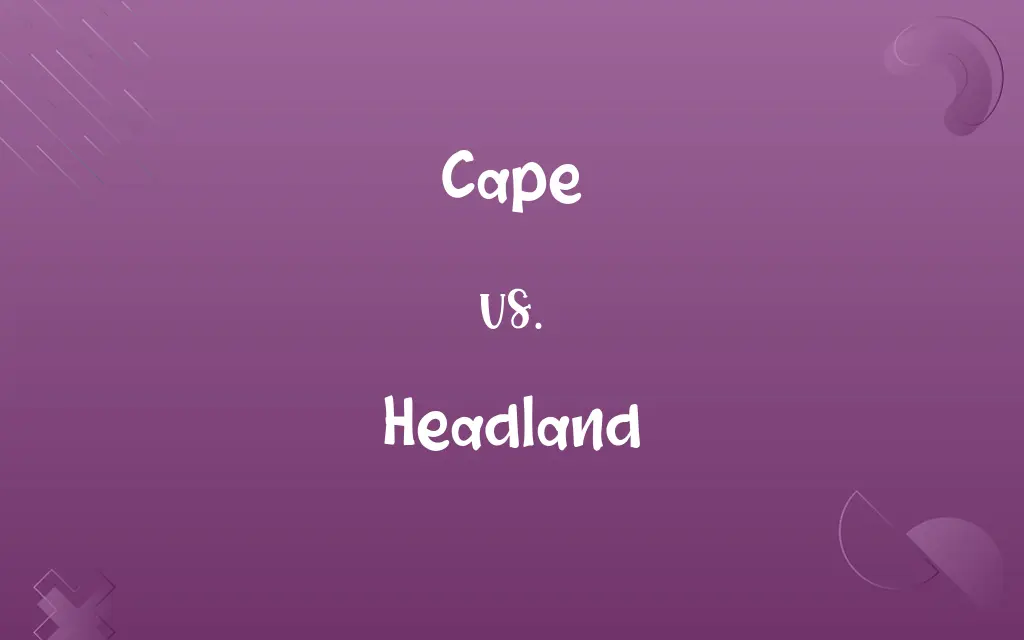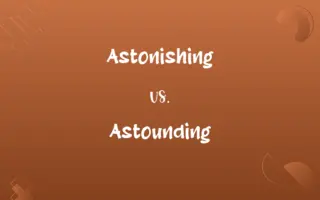Cape vs. Headland: Know the Difference

By Shumaila Saeed & Hifza Nasir || Updated on March 7, 2024
Cape refers to a high point of land extending into a body of water, often marked by a significant change in direction, while headland is a broad, elevated area of land projecting into the sea, typically with steep cliffs.

Key Differences
A cape is a pointed piece of land jutting out into a sea, ocean, lake, or river, marked often by a notable change in the contour of the coastline. It can be used for navigation as a landmark. Headlands, on the other hand, are characterized by their high elevation and steep cliffs facing the water, forming a prominent feature along the coastline. They are more about the dramatic intersection of land and sea rather than navigation.
Hifza Nasir
Mar 07, 2024
Capes are usually notable for altering the direction of travel for coastal navigators, providing a marked point that can be identified on maps and by sailors. While headlands also serve as navigation markers, their significance lies more in their geographical and ecological impact, often hosting unique plant and animal life due to their exposure to wind and sea.
Shumaila Saeed
Mar 07, 2024
In terms of formation, capes can be created by various geological processes, including the erosion of land by the sea, the buildup of sediment, or volcanic activity. Headlands are primarily formed by erosion but are distinguished by their resistance to weathering, which allows them to protrude into the sea as elevated land.
Shumaila Saeed
Mar 07, 2024
When it comes to human activity, capes are often the sites of lighthouses, small settlements, or ports, owing to their strategic location along shipping routes. Headlands, due to their rugged terrain and elevation, are less likely to be developed but may feature hiking trails or scenic viewpoints, taking advantage of their panoramic views.
Hifza Nasir
Mar 07, 2024
The distinction between capes and headlands lies not just in their physical characteristics but also in their relationship with the surrounding landscape and human use. While both are important coastal features, capes tend to be more integrated into human navigation and settlement patterns, whereas headlands remain more natural and undeveloped, offering breathtaking views and serving as a testament to the power of natural erosion.
Dua Fatima
Mar 07, 2024
ADVERTISEMENT
Comparison Chart
Definition
Point of land extending into water
Broad, elevated land projecting into sea
Shumaila Saeed
Mar 07, 2024
Formation
Erosion, sediment buildup, volcanic
Erosion, resistant to weathering
Shumaila Saeed
Mar 07, 2024
Human Use
Navigation, settlement, lighthouses
Scenic viewpoints, less developed
Shumaila Saeed
Mar 07, 2024
ADVERTISEMENT
Cape and Headland Definitions
Cape
A point of land extending into a body of water.
Cape Cod is a popular vacation destination in Massachusetts.
Shumaila Saeed
Mar 07, 2024
Headland
Formed by erosion.
The rugged headland has been shaped by centuries of wind and water erosion.
Dua Fatima
Mar 07, 2024
Cape
Site for lighthouses and ports.
The Cape is home to an historic lighthouse.
Hifza Nasir
Mar 07, 2024
Headland
Elevated land projecting into the sea with steep cliffs.
The headland offers stunning views of the crashing waves below.
Shumaila Saeed
Mar 07, 2024
Cape
Extends into seas, oceans, lakes, or rivers.
The Cape juts out into the ocean, providing breathtaking views.
Hifza Nasir
Mar 07, 2024
ADVERTISEMENT
Headland
Less developed due to terrain.
The steep cliffs of the headland deter significant development.
Shumaila Saeed
Mar 07, 2024
Cape
Landmark for navigation.
Sailors often use Capes as navigational markers.
Shumaila Saeed
Mar 07, 2024
Headland
Features unique ecosystems.
Rare plants and animals thrive on the isolated headland.
Dua Fatima
Mar 07, 2024
Cape
Alters coastline direction.
The coastline takes a dramatic turn at the Cape.
Dua Fatima
Mar 07, 2024
Headland
Offers panoramic scenic viewpoints.
Hikers flock to the headland for its panoramic sea views.
Hifza Nasir
Mar 07, 2024
Headland
A point of land, usually high and with a sheer drop, extending out into a body of water; a promontory.
Shumaila Saeed
Oct 19, 2023
Cape
A piece or point of land, extending beyond the adjacent coast into the sea or a lake; a promontory; a headland.
Shumaila Saeed
Oct 19, 2023
Cape
To head or point; to keep a course; as, the ship capes southwest by south.
Shumaila Saeed
Oct 19, 2023
Headland
A cape; a promontory; a point of land projecting into the sea or other expanse of water.
Shumaila Saeed
Oct 19, 2023
Headland
A ridge or strip of unplowed at the ends of furrows, or near a fence.
Shumaila Saeed
Oct 19, 2023
Headland
A natural elevation (especially a rocky one that juts out into the sea)
Shumaila Saeed
Oct 19, 2023
Repeatedly Asked Queries
Can a cape have cliffs?
Yes, a cape can have cliffs, especially if formed by volcanic activity or erosion, but its defining feature is its pointed shape extending into water.
Shumaila Saeed
Mar 07, 2024
How do headlands form?
Headlands form through the process of erosion, where land resistant to weathering projects into the sea.
Shumaila Saeed
Mar 07, 2024
Are there any famous examples of headlands?
Famous examples include the Cliffs of Moher in Ireland, known for their dramatic scenery.
Dua Fatima
Mar 07, 2024
How are capes used in navigation?
Capes serve as prominent points for sailors to navigate by, often marked on nautical maps.
Shumaila Saeed
Mar 07, 2024
What role do capes and headlands play in coastal ecosystems?
They play a critical role by providing unique habitats, influencing local climates, and acting as barriers against sea erosion.
Shumaila Saeed
Mar 07, 2024
What defines a cape?
A cape is a pointed piece of land that extends into a body of water, often serving as a navigational landmark.
Hifza Nasir
Mar 07, 2024
Why are headlands significant for biodiversity?
Headlands are significant for biodiversity because their unique location and conditions support diverse plant and animal life.
Hifza Nasir
Mar 07, 2024
Do capes always change the direction of coastlines?
While not always, capes commonly mark a significant change in the direction of a coastline.
Shumaila Saeed
Mar 07, 2024
What activities might one do on a headland?
Activities include hiking, bird watching, or enjoying scenic views due to their elevated and rugged nature.
Shumaila Saeed
Mar 07, 2024
What's the difference between a peninsula and a cape?
A peninsula is a large landform that extends into a body of water, usually surrounded on three sides by water, whereas a cape is a specific point that projects into water, often smaller than a peninsula.
Dua Fatima
Mar 07, 2024
Is erosion always harmful to headlands?
Erosion shapes headlands and can create their dramatic features, but excessive erosion can threaten their stability and ecosystems.
Hifza Nasir
Mar 07, 2024
Can human activity affect capes and headlands?
Yes, human activity, including development and conservation efforts, can impact both capes and headlands.
Hifza Nasir
Mar 07, 2024
Can a headland become a cape?
Geologically, a headland could be considered a cape if it extends into the water in a pointed fashion, but they are typically defined by their distinct characteristics.
Shumaila Saeed
Mar 07, 2024
Are capes and headlands protected areas?
Many capes and headlands are protected due to their environmental, historical, or navigational significance.
Shumaila Saeed
Mar 07, 2024
How does the public access capes and headlands?
Access varies by location; some are within public parks or reserves, while others may be on private land or restricted areas.
Dua Fatima
Mar 07, 2024
Share this page
Link for your blog / website
HTML
Link to share via messenger
About Author
Written by
Shumaila SaeedShumaila Saeed, an expert content creator with 6 years of experience, specializes in distilling complex topics into easily digestible comparisons, shining a light on the nuances that both inform and educate readers with clarity and accuracy.
Co-written by
Hifza Nasir








































































